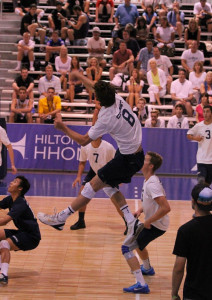While high school student-athletes certainly dedicate a lot of time and energy to refining their craft, the collegiate lifestyle brings a new level of challenge that many incoming freshmen can find daunting and overwhelming at first. In addition to being under much more pressure to perform on a bigger, more exposed stage in front of a national audience, they must also deal with the challenges that regular college freshmen face: making friends, settling into a community and creating a niche in an unfamiliar setting.

It’s a tough, multifaceted adjustment, but among the many different elements many players feel that the intense workload of college athletics is one of the most difficult aspects to adapt to.
“In high school, I would practice two to three times a week,” said freshman men’s volleyball player Clay Jones. “But here, it’s five days a week…Just trying to get through the day is pretty difficult just because our practices are so long.”
The level of conditioning and intensity for athletes at Stanford is far beyond that of high school due to the increased speed and talent at the collegiate level. As a result, it is difficult for collegiate coaches to ease the transition for younger athletes, as they must facilitate the adjustment to a more rigorous load as quickly as possible in order to foster collegiate contenders.
“Our coaches are definitely all business,” said sophomore Kiran Lakhian, a former women’s basketball player. “It’s just their job to stick to basketball.”
The coaches tell a similar story of pressure and expectations.
“I think there is a lot of internal pressure,” said men’s crew assistant coach Jake Cornelius. “As coaches, we reframe what’s important.”
Perhaps even more difficult than the massive workload of a student-athlete is the mental transition for many high school stars becoming college benchwarmers. To be recruited by Stanford, athletes have to prove themselves head-and-shoulder above their high school and club competition. However, now amongst the top competitors in their respective sport, many incoming freshmen find the adjustment from superstar to second-string player a tough reality.
“[Before] we come here, we’re the best at our sport and the best in the classroom,” said junior women’s soccer player Haley Rosen, “and then we come to Stanford and we’re average at best, on a good day.”
Jones, for one, wasn’t quite ready to relinquish his stardom upon stepping on the Cardinal men’s volleyball court.
“I was expecting that I would come in right off the bat and play my best volleyball every day at practice and that I would be in peak condition,” Jones said. “That was one thing that I wasn’t prepared for: the level of play of college volleyball.”
With the four or five-year cycle of collegiate athletics constantly in motion, however, many of those student-athletes see their behind-the-scenes hard work pay off when they are eventually called upon to fill vacant spots left by departing seniors. And when they get that chance, it becomes a validation of their hard-fought — but successful — transition from a fresh-faced high school graduate to a full-time collegiate athlete.
Contact Carlie Tenenbaum at carliet ‘at’ stanford.edu.
